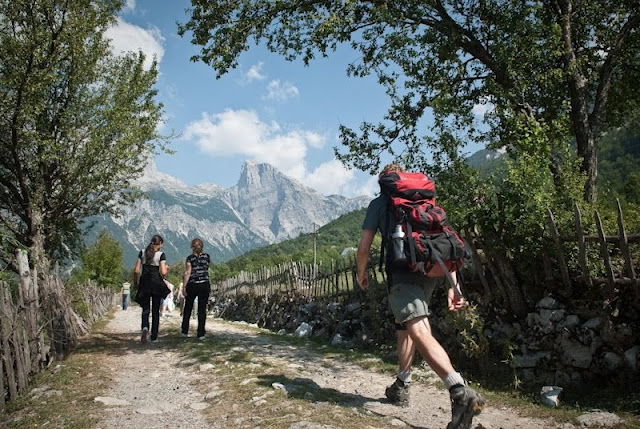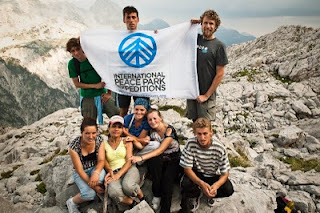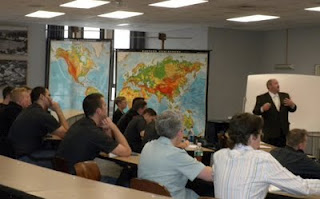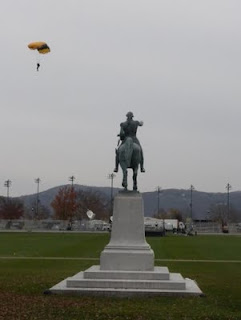Showing posts from category Campus Beat.
-
‘Campus Beat:’ Finding a Home for Political Demography
›May 13, 2010 // By Richard CincottaDoes political and security demography have a professional society that it can call “home”? Research in this field—the study of the political and security-related consequences of demographic conditions and trends—already has an intellectual home within the Environmental Change and Security Program. But has it secured a place for itself among disciplinary academic societies?
In search of an answer, I undertook some serious “conference stalking” over the past year, attending the annual meetings of the International Studies Association (ISA), and the American Political Science Association (APSA). At the end of April, I returned from two more—the Population Association of America (PAA), held in Dallas, TX; and the American Association of Geographers (AAG), in Washington, DC.
International Studies Association
From my perspective, ISA currently offers the most promise for graduate students and young analysts who would like to participate in, or use results from, political and security demography. While the audiences at ISA’s political demography sessions have not been spectacularly large (usually fewer than 20 people), ISA is the only academic society, to my knowledge, that has organized a formal “Political Demography Section” to advance the field. (Former ISA president Jacek Kugler of Claremont Graduate University led the charge last year.)
(Editor’s note: At the 2010 ISA conference, ECSP organized a roundtable on “Strategies for Bridging Research and Policy in the Classroom: Teaching Environment, Population, Conflict, and Security.” A panel of four educators discussed the unique challenges facing those that attempt to teach hybrid security issues. Panelist Jennifer Sciubba’s presentation, in which she shared techniques for bridging the gaps that exist between the study of political science and issues of population and environment, is posted on the New Security Beat.)
Population Association of America
In terms of fostering political demography, PAA, the professional organization for American demographers, currently ranks second. Despite the lack of a formal section, PAA’s 2010 conference included several sessions on research germane to politics and security, including “Demographic Determinants and Consequences of War, Conflict and Terrorism; “21st Century Refugee Policy and Refugee Demography”; and “Population, Politics, and Conflict in the Middle East.”
The session on the Middle East, which was moderately well attended and fostered an animated discussion, featured papers on: internal migration during the 2006 Israel-Lebanon War (Marwan Khawaja and Shireen Assaf); demographic projections for Israeli ethnoreligious groups (Eric Kaufman and myself); and a discussion of possible demographic outcomes from the creation of a Palestinian state (Uzi Rebhun).
The PAA session on the demographic determinants and consequences of violent conflict focused on the human costs: forced migration’s impact on child survival in Angola (Winifred Avogo); impact of terror on birth rates in Israel (Guy Stecklov); the death toll in Cambodia (Patrick Heuvaline); and long-term consequences of war and genocide in Bosnia and Rwanda (Sarah Statveig).
While these topics—the demographic consequences of conflict—are important to international health and relief organizations, they don’t fit well within (my conceptualization of) political and security demography. In introducing the session, its chair, CUNY’s Neil Bennett, called attention to the absence of this perspective, by noting that he received over a dozen submissions on the demographic consequences of conflict, but only one submission (which was not selected for presentation) that hypothesized demography as a determinant of conflict.
The ebbing of political demography among demographers is a legacy of demography’s development over the past generation. Today, PAA annual meetings and the society’s journal, Demography, are dominated by what I call “passive demography”—programs hypothesizing the influence of social, health, economic, or political conditions on demographic trends; or research that employs demographic characteristics as categories for which sociological and health conditions are assessed (as in studies of the aged, urban residents, ethnoreligious groups, women of childbearing age, school-age children, etc.).
But even as the majority of academic demographers were settling into this approach, another group—mostly theoreticians—were digging through census and hospital records to identify how populations entered and passed through the demographic transition. Their efforts ultimately produced today’s population estimates and projections (published by the UN Population Division and U.S. Census Bureau’s International Program Center).
The parallel development of these perspectives produced a somewhat schizophrenic discipline. While demography is unmatched in its abilities among peer social sciences to project—with surprising accuracy and clarity—two to three decades into the future, most demographers are uncomfortable ascribing meaning to demographic conditions or trends.
There are, of course, exceptions: active approaches that hypothesize influences of demographic factors on non-demographic conditions. For example, economic demography, which owes its origins to Ansley Coale’s early theorization of the demographic bonus, is focused on the influences of age structural changes on the economy of states. More recently, PAA organized a section that combines economic demography, population-environment studies, and other active demographic fields into the Population, Environment, and Development Section.
American Association of Geographers
The annual conference of the American Association of Geographers (AAG) seemed like a good fit. Geographers are interdisciplinary by training, and AAG has already organized formal “specialty groups” on political geography and population geography. Despite these advantages, few senior geographers (if any) have worked at the intersection of these two specialties.
For AAG 2010, Col. Laurel Hummel (USMA, West Point) and I organized a session titled “Demography as a Dynamic Predictor of Political, Developmental and Security Outcomes.” The four presentations included: liberal democracy and demography (John Doces and myself); the evolution of urban and rural age structures during the demographic transition (Elizabeth Leahy Madsen); and a demographic study of a voting in the U.S. Upper Midwest (Peter Camilli). Unfortunately, our session was scheduled on the final day and poorly attended.
Nonetheless, I was impressed at the number of population-related sessions at AAG 2010, including several related to population’s interactions with environmental conditions (tropical forest settlement; climate change’s possible health and demographic impacts) and on demographic issues of political consequence (China’s one-child policy; the geography of Sweden’s conscription and its future).
American Political Science Association
I’ve been most surprised to find that efforts to spark interest in political demography at APSA conferences have not been overly successful. Sessions that focus on the implications of religious demographic differences have gained some support from APSA’s Religion and Politics Section, but in general, political scientists have yet to embrace either political demography’s methods or its findings. In a 2005 interview with Robert Putnam and M. Kent Jennings, both past presidents of APSA, demographic change was identified as being among the most predictable of future trends, yet the least studied by political scientists.
A recent article in Foreign Affairs, “The Next Population Bomb” by Jack Goldstone (George Mason U.), could break down a few of political science’s disciplinary barriers. However, the fences seem exceptionally high. Despite being identified as a session “of special interest” at the 2009 APSA conference, “Demography and Security: The Politics of Population Change in an Age of Turbulence” (organized by Eric Kaufmann, U. London) was sparsely attended.
Political and security demography’s progress is as erratic as it is paradoxical. While demand in the security community grows for the field’s products, they appear to pass virtually unnoticed in academic circles.
But there’s a bright side to this puzzle. ISA draws a substantial portion of its membership from analysts in security think-tanks and among intelligence and defense-related agencies—and for that reason it may, after all, be the most comfortable spot for analysts pursuing political and security demography to call “home.”
Richard Cincotta is a consultant with the Environmental Change and Security Program and the demographer-in-residence at the H.L. Stimson Center in Washington, DC.
Photo Credit: “World population” courtesy of Flickr user Arenamontanus. -
VIDEO – A World of Water: Teaching Water Conflict and Cooperation in the Classroom
›April 21, 2010 // By Julien Katchinoff“Water conflict is not just about an international river basin and it’s not just about conflict around a well. There’s a whole spectrum of water conflict that we try to get into,” says Sandy Ruckstuhl, senior social scientist at the Center for Complexity Analysis, LLC. Ruckstuhl also teaches a course on water and conflict at the George Mason University’s Institute for Conflict Analysis and Resolution.
Many students drawn to her course have backgrounds in human rights and approach the topic from a “right to water” framework. Ruckstuhl’s course is designed to expand their views. “This discussion is much broader than a debate around rights. There are all sorts of dimensions to water conflict, to water management, that have to do with different levels of governance, different physical challenges in dealing with the resource, different cultural contexts—there are all sorts of factors that are at play when we talk about an issue like water conflict and water cooperation,” she said.
Ruckstuhl takes her students on an exhaustive journey through 10 case studies, touching on cross-cutting topics, such as environmental security and climate change, and their impacts across a range of critical regions, from deserts in the Middle East and Darfur to the Altiplano in Bolivia. Ruckstuhl’s students also benefit from guest lectures presented by water practitioners and experts in the field, including ECSP Director Geoff Dabelko, Ambassador John McDonald, and the Henry L. Stimson Center’s David Michel. -
Watch: Jennifer Dabbs Sciubba on Bringing Demography Into the Classroom
›April 7, 2010 // By Julien Katchinoff“You can’t just mention [population] in passing…If you’re going to talk about it, [students] will probably be interested in it, and you have to give it a really serious treatment,” cautioned Jennifer Sciubba, Mellon Environmental Fellow and professor at Rhodes College, during a panel discussion on science and policy in the classroom at the 2010 International Studies Association Conference.
Drawing on her experience as a practitioner of population studies, both within the Beltway and in the classroom, Sciubba shared techniques for bridging the gaps that exist between the study of political science and issues of population and environment. “I don’t think there’s that much of a difference between policy makers and students in some ways. They want to know the solutions, and they want you to break it down for them,” she said.
Bringing demography into the classroom should not start with population, recommended Sciubba. Rather, population and environment should be thought of as elements that shape and facilitate understanding of each topic covered in International Relations theory, from issues of conflict, war, and cooperation, to economics and development.
“It’s possible,” she concluded, “to put these things in any course–they’re part of the discipline. If we go back to some of the roots of international relations, this is how people thought of it to begin with and it’s very interesting to get back to that.”
Jennifer Sciubba is the author of a forthcoming book on demography and security, The Future Faces of War: Population and National Security, Praeger International Security Press, 2010
-
Imagine There Are No Countries: Conservation Beyond Borders in the Balkans
›International peace parks have captured the imagination of visionaries like Nelson Mandela, who called them a “concept that can be embraced by all.” Such parks—also known as transboundary protected areas—span national boundaries, testifying to the peaceful collaborative relationship between neighboring countries and to the co-existence of humans and nature.
Peace parks seek to simultaneously promote regional peace and stability, conserve biodiversity, and stimulate job creation. How can they accomplish such ambitious goals?- Biodiversity: The political borders and physical barriers within the park are removed, allowing animals and humans to migrate freely. In addition, surveys of the area’s biodiversity don’t stop at sovereign borders, but are instead conducted on an ecosystem basis.
- Job creation: Developing eco-tourism—one of the fastest-growing industries in the world—provides people living near peace parks an incentivized alternative to exhausting the very resource base on which their survival depends.
- Peace and stability: To jointly manage natural resources successfully requires countries to collaborate through cross-boundary committees on conservation, safety and security, finance, human resources, legislation, and tourism.
 My organization, International Peace Park Expeditions, uses experiential peacebuilding, academic programs, and professional trainings in international peace parks to integrate theory with practice. We seek to develop leadership and collaboration among three distinct, but complementary, groups: students and professors, transboundary protected area professionals, and youth from the peace park countries.
My organization, International Peace Park Expeditions, uses experiential peacebuilding, academic programs, and professional trainings in international peace parks to integrate theory with practice. We seek to develop leadership and collaboration among three distinct, but complementary, groups: students and professors, transboundary protected area professionals, and youth from the peace park countries.
Our Summer 2010 programs focus on the proposed peace park in the Western Balkans’ Prokletije/Bjeshket e Namuna mountains, between Albania and the newly independent countries of Montenegro (2006) and Kosovo (2008), which were formerly part of Yugoslavia. The Balkans Peace Park Project, a UK charity and their local network of partner organizations and individuals, first conceptualized the Balkans Peace Park, an area of approximately 4000 square km, in 2001.
This summer, participants in our professional training symposium will collaboratively develop a more precise and dynamic map. Students and young leaders in our other two programs will learn about peace parks while trekking together across the borders into all three countries.
Experiential Peacebuilding (July 19-25, 2010)
Experiential Peacebuilding programs combine outdoor experiential education and practical skills training in peacebuilding to foster the development of a community of young leaders capable of catalyzing positive peaceful changes in their communities. This summer’s program is being developed in conjunction with our local partner organizations (ERA and Marimangut in Kosovo; Outdoor Albania and High Albania in Albania; and PSD Prokletija in Montenegro). The primary goals of these programs are to unite youth from conflict-affected communities to develop relationships across borders; transform negative attitudes and stereotypes; and create a core group of young leaders with the skills, tools, and motivation to generate and direct changes in their communities.
Academic Expedition (June 7-26 and August 2-21, 2010)This three-week, three-credit course, “Conservation Beyond Borders,” will combine traditional academic teaching with proven experiential learning methodologies to create a unique, dynamic expedition that will provide students with a strong understanding of the theory and practice of international peace parks. Course readings and lectures will provide the academic base, and guest lectures from subject-matter experts working in the field will create the bridge; both will address sustainable forestry management, biodiversity surveys, eco-tourism plans, development and infrastructure planning, environmental conservation, water resource management, peacebuilding initiatives, and cross-border projects. First-hand experience trekking through the proposed Balkans Peace Park, crossing the borders of Albania, Kosovo, and Montenegro, and living among the local people will bring theory to life.
Professional Training Symposium (July 8-9, 2010)
This year’s Professional Field Training Symposium, “Critical Transboundary Environmental Linkages,” will bring together experts, policymakers, and stakeholders from the Prokletije/Bjeshket e Namuna region to discuss cross-border ecotourism, biodiversity mapping, and sustainable forestry management. The symposium seeks to build trust through cross-border collaboration, and to improve environmental management in the peace park region. Participants will create a Google Earth map to house shared environmental data and visit two project sites in the proposed peace park. Todd Walters is the founder and executive director of International Peace Park Expeditions. He holds a master’s degree in International Peace and Conflict Resolution from American University’s School of International Service, and is a National Outdoor Leadership School (NOLS) certified wilderness guide. While at AU, he worked as an intern for the Environmental Change and Security Program.
Todd Walters is the founder and executive director of International Peace Park Expeditions. He holds a master’s degree in International Peace and Conflict Resolution from American University’s School of International Service, and is a National Outdoor Leadership School (NOLS) certified wilderness guide. While at AU, he worked as an intern for the Environmental Change and Security Program.
Photos courtesy IPPE/Cory Wilson. -
The Campus Beat: Using Blogs, Facebook, to Teach Environmental Security at West Point
›November 17, 2009 // By Geoffrey D. Dabelko The lecture was only a few hours away. In desperation, I turned to Facebook. “I’ve got just 50 minutes with the cadets at West Point today to talk water, conflict, and cooperation. What are the most compelling examples you would use to make both hard security and human security points, both threat and opportunity points? I ask in part because it is proving harder to decide what to leave out than what to put in!”
The lecture was only a few hours away. In desperation, I turned to Facebook. “I’ve got just 50 minutes with the cadets at West Point today to talk water, conflict, and cooperation. What are the most compelling examples you would use to make both hard security and human security points, both threat and opportunity points? I ask in part because it is proving harder to decide what to leave out than what to put in!”
Within seconds, experts from the Departments of State and Energy, USAID, and National Geographic responded with examples, including the Tibetan plateau and glacial melt, the lower Jordan River, and more. I used these cases and others to break through to an audience that included both those skeptical of “treehugger” issues and those eager to learn. The map of Chinese current and planned hydro projects produced audible gasps and wide eyes among the class of future officers.
While at West Point, colleague Meaghan Parker and I met with geography faculty to better understand how and what they are teaching on environmental security and demographic security. The professors on the banks of the Hudson face similar challenges to their non-military brethren; today’s students have shorter attention spans and lack experience conducting in-depth research (or getting beyond Google).
But some challenges are unique to the service academies: isolation from academic peers; the need to make sure the material is relevant to future military l eaders; and most of all, the physical and mental demands on cadets’ time placed by army training. I saw it as a sign of success that I only had three stand up during my lecture, the military’s sanctioned way to keep yourself awake in class. (LTC Lou Rios USAF, one of the faculty members we met with, wrote about teaching environmental security at West Point previously on New Security Beat.)
eaders; and most of all, the physical and mental demands on cadets’ time placed by army training. I saw it as a sign of success that I only had three stand up during my lecture, the military’s sanctioned way to keep yourself awake in class. (LTC Lou Rios USAF, one of the faculty members we met with, wrote about teaching environmental security at West Point previously on New Security Beat.)
Video, blogs, and other new media seem like a way to bridge some of these gaps. We’re especially excited that the cadets in at least three courses will be using the New Security Beat as part of their classes by reading posts, commenting, and proposing a post on a topic of their choosing. We’re looking forward to a cadet joining us next summer for internship with ECSP.
All of these outreach efforts are part of our strategy to both understand how all types of actors—including future army officers—come to understand environment and security links while providing insights and analysis to that same diverse group.
Photos by Geoff Dabelko and Meaghan Parker











